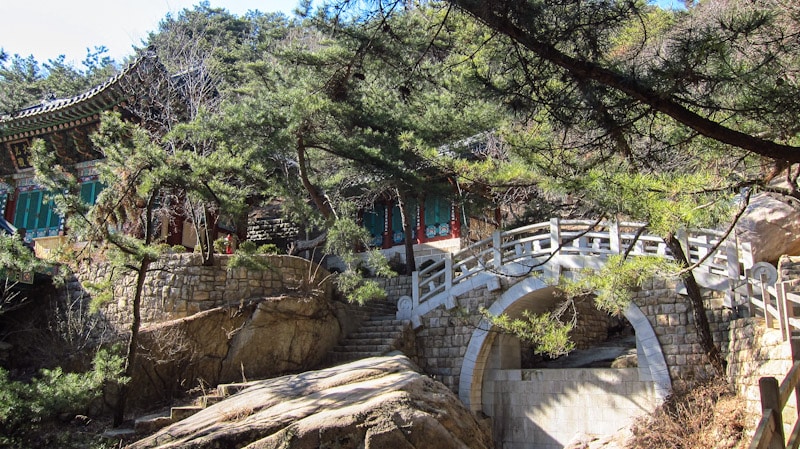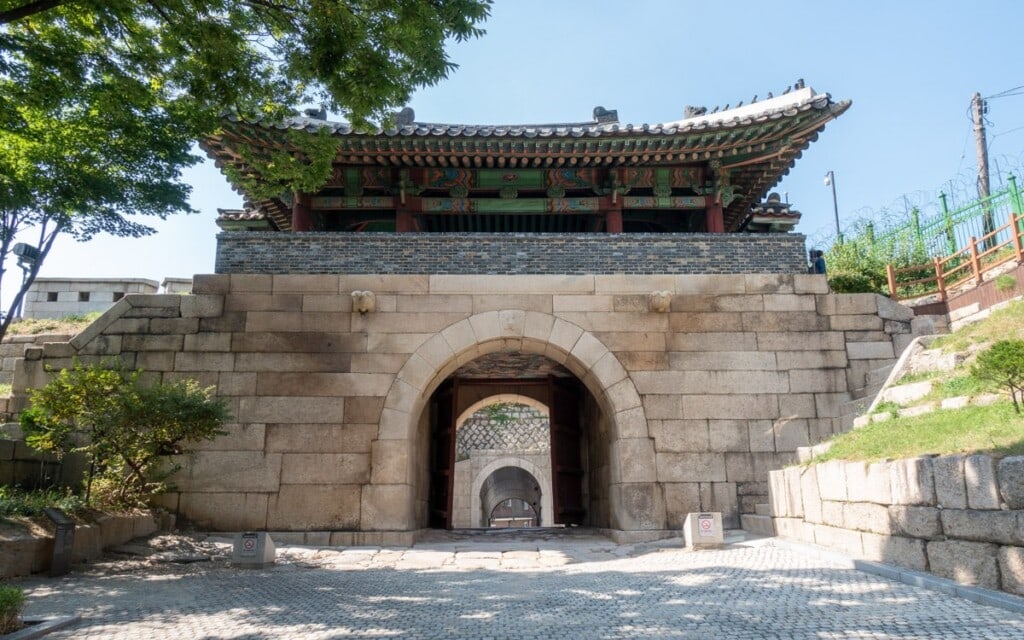
Jingwansa Temple is a Buddhist temple located in Bukhansan National Park on the western outskirts of Seoul, not far from Eunpyeong Hanok Village. Jingwansa is one of four temples considered to be the most prestigious in Seoul. The others include Bulmasa Temple in the east, Sammaksa Temple in the south, and Seunggasa Temple in the north.
Jingwansa Temple, which was built to replace Sinhyeolsa Temple, was constructed in 1010 during the rule of King Hyeonjong of the Goryeo Dynasty. Hyeonjong, who was the 8th ruler of the Goryeo dynasty of Korea from 1009 to 1031, was a grandson of Taejo of Goryeo.
Jingwansa Temple was built by Hyeonjong in appreciation of Buddhist priest Jingwan, who had saved the king’s life during his ascension to the throne. The temple stands as a tribute to Jingwan’s heroism and unwavering devotion to the king.
During the Joseon Period (1392-1910), Jingwansa Temple served as a venue for the state-sponsored Land and Water Ceremony (Suryukjae). Sagadokseodang, a government-run library, was established here by King Sejong during his reign as the fourth Joseon king from 1418 to 1450. The library served as a space for Jiphyeonjeon scholars and intellectuals to visit and engage in reading activities. They also studied the Korean writing system, which today is known as Hangeul.
The temple grounds suffered extensive damage during the Korean War from 1950 to 1953, with only a handful of buildings managing to survive the devastation. Starting in 1963 and led by the head monk of the temple, a 30-year reconstruction effort was initiated to restore the temple grounds. Although it was a lengthy process, many of the temple buildings were eventually restored to their previous condition.
At Jingwansa Temple, visitors also have the opportunity to participate in a Templestay program. This program and cultural experience offers a glimpse into the history of Korean Buddhism and the daily life of Buddhist practitioners.
Chilseonggak Hall

Constructed in 1907, Chilseonggak Hall enshrines the deity Chilseongsin, a significant figure in Korean Buddhist folklore and believed to be the god of fortune and protector against calamities. During the early 20th century, Chilseonggak Hall underwent renovations. Despite being damaged during the Korean War, the hall was one of the few structures to survive the conflict.
Chilseonggak Hall houses a Buddhist altar situated close to the rear wall, a seated stone Buddha statue (Seoul Cultural Property Material No. 10), and a Buddhist painting (Seoul Tangible Cultural Property No. 147). The painting depicts Vairocana Buddha (Chiseonggwang Yeorae), considered to be a central figure in many East Asian Buddhist traditions. The painting also depicts Chilseongsin and other sage kings.
Restoration work on Chilseonggak Hall in 2008 led to the discovery of an old Taegeukgi (Korean national flag) and anti-Japanese newspapers. This discovery revealed that the temple was a base for the Korean Independence Movement during Japanese colonial rule (1910-1945).
Dokseongjeon Hall

The construction of Dokseongjeon Hall in 1907 was made possible with the help of four court ladies and two civilian couples. They provided the funding for the project while construction was carried out by a skilled monks.
Dokseongjeon Hall enshrined Dokseong, also known as Naban jonja. Dokseong was an arhat who became a monk to save the public right after Sakyamuni’s entry into Nirvana. Dokseong is a figure in Korean Buddhism who embodies the ideal of detachment and solitary practice. He is often depicted as a Daoist-style hermit and serves as an ideal for those who seek to follow a path of solitude and detachment.

The interior of the hall features a Buddhist altar, a statue and painting of Dokseong, and a Buddhist painting known as Sansindo. Sansindo often depict the gods or spirits believed to reside in the mountains. These paintings often feature images of various deities associated with the mountains. The painting in this hall (Seoul Cultural Property Material No. 12) from 1907 shows Naban Jonja and Dongja seated, with Mount Tiantai in the background. The statue of Dokseong (Seoul Cultural Property Material No. 11) is a small pottery figurine that measures only 37 cm in height.
Jingwansa Temple Information
Hours
24 hoursAdmission
Free
Address
73 Jingwan-gil, Eunpyeong-gu, Seoul, South Korea
GPS Coordinates: 37.638168, 126.946656
Jingwansa Temple Video
Map
Additional Resources
Viator by TripAdvisor
Viator is a popular online platform that helps travelers book tours, activities, and unique experiences worldwide, including in Seoul. It connects users with a wide selection of options – from sightseeing tours to cultural events and outdoor adventures – all offered by local providers.
Klook
Klook offers discounted tickets and reservations for various attractions and services in Seoul, from theme parks and museums to tours and transportation options.
Rakuten
Save money while exploring Seoul with Rakuten's cashback program. Book your hotels or other services through Rakuten and enjoy cashback rewards and exclusive deals.
If you sign up using the link below, you could earn $30 cashback on your first purchase over $30.
Book Recommendations
For an immersive guide to Seoul, many travelers choose to bring a book along. Fodor's Seoul, for example, offers detailed recommendations on sights, restaurants, maps, and travel tips.
Nearby Sights
Geumsunsa Temple

Geumseonsa Temple is a Buddhist temple situated to the north of central Seoul. It is located not far from Gyeongbokgung Palace and Cheong Wa Dae (The Blue House). Although situated near central Seoul, its location within Bukhansan National Park, sometimes referred to as Samgaksan, makes it feel a world away from the city's hustle and bustle.
Segeomjeong Pavilion

Segeomjeong Pavilion is a pavilion located on Hongjecheon Stream at the base of Mount Bugaksan in northwest Seoul. Due to its location, surrounded by nature, and built on a stream, the pavilion has been mentioned in many literary works, poems, and essays over the years. While historians aren't exactly sure when the pavilion was first built, its history dates back hundreds of years.
Hongjimun Gate and Tangchundaeseong Fortress

Hongjimun Gate is the main gate of Tangchundaeseong Fortress, built in 1719 during King Sukjong's reign. It served as a key defensive structure linking the Seoul City Wall (Hanyangdoseong) with Bukhansanseong, strengthening the capital's fortifications. Situated on the northern side of Hanseong, the name of Seoul during the Joseon Dynasty, Hongjimun was also called Hanbukmun.
Read more about Hongjimun Gate and Tangchundaeseong Fortress
Changuimun Gate (Jahamun Gate)

Changuimun Gate, located in northern Seoul, is one of the Four Small Gates of Seoul Fortress. In the past, the gate has also been known as Jahamun and Buksosomun. Construction started in 1396 during the beginning years of the Joseon Dynasty. Built north of the city, Changuimun became a major link between the city and areas to the north.
Last Updated on Apr 24, 2023

